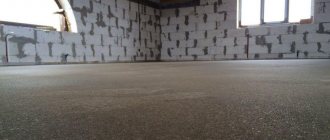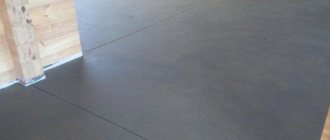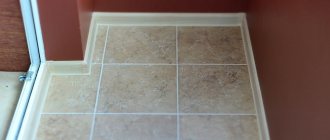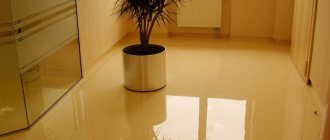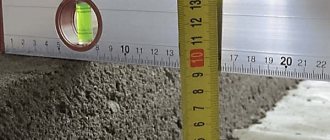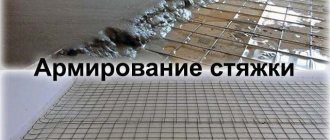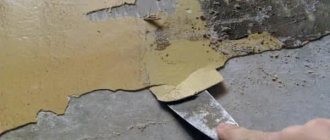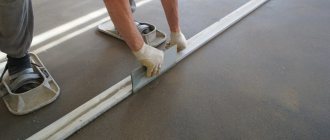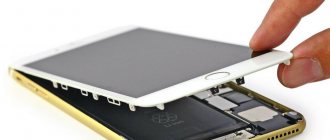The service life of tiles and parquet is significantly influenced by the strength of the rough concrete screed. It is reinforced to prevent premature peeling and destruction. Previously, a metal mesh was used for this, but now there is a modern, inexpensive and more effective way to strengthen the structure - fiberglass for floor screed. What is fiber fiber? How to choose it and use it correctly? Read the material provided.
Fiber fiber for floor screed
Fiber fiber
What is it and why is it needed
Fiber fiber, or simply fiber, is a reinforcing additive in various building mixtures and solutions. By adopting a chaotic arrangement inside the concrete, it improves its quality characteristics, such as abrasion, strength, etc. In addition, fiber-fiber concrete better resists bending and tensile loads. All this is very important for floor screed.
Fiber is very strong thin fibers ranging from 6 mm to 20 mm in length. The size of reinforcing additives affects the characteristics of concrete differently, so the following is used:
- 6 mm - in mortars for cladding and masonry;
- 12 mm - screeds and various monolithic concrete products;
- 18-20 mm - in structures operated in extreme conditions, for example, dams.
It is produced in the form of crumbly material from glass, metal, basalt and polypropylene. It begins to influence the screed already at the stage of mixing the solution - it actively influences future physical and chemical processes that will begin after pouring, in two directions at once.
1. A solution with reinforcing additives requires less water to completely mix. Consequently, during the hydration process, the screed will gain strength faster, and excess moisture will not actively evaporate, forming microvoids and a network of small cracks.
Illustration of fiber distribution inside concrete.
For information: in any solution there are voids. In a traditional mixture of cement and sand, they are filled with water; in a reinforced mixture, they are filled with fibers. Therefore, you need less water up to 20%.
2. By filling all voids after pouring, fiber fiber prevents the formation of microcracks in the first 5-7 hours of setting of the solution.
For information: at the initial stage of hydration, internal stresses appear in the pouring body due to micropores and different rates of hardening, which manifests itself in a network of cracks on the surface of any concrete product. The use of reinforcing fibers allows, firstly, to fill voids and, secondly, to evenly distribute moisture inside the concrete product, as a result of which the hardening process proceeds evenly, which reduces internal stresses to zero.
At the second stage of hydration, when ordinary concrete begins to shrink and cracks appear, the fiber fibers hold the screed in its original dimensions, as a result of which cracks do not form. If they do appear, then due to the multidirectional effect of the reinforcing fibers on the concrete surface, the resulting gaps between the cement particles are tightened.
Tools for work
Before you start reinforcing the floor screed with fiberglass, you need to take care of the tools. In your work you will need: cement, sand, fiber, aluminum profile, level and ruler, usually a tape measure, spatula, a tool for mixing the solution (drill, pneumatic blower), knife, screws, screwdriver. Sea sand should be used, size 2.6-3, cement with grade 400 or 500. In addition to fiber, you need to use an additive that plasticizes the mixture.
Tool for screeding fiber-fiber floors
Advantages of use and disadvantages
The inclusion of fiber fiber in the cement-sand composition gives the screed significant advantages over the classic version of the mortar.
- In concrete, fiber acts as a reinforcing element, which increases its strength and elasticity. It can withstand increased loads from above, both dynamic (impacts, resonant vibrations) and static (high specific pressure per 1 m2), and from below (shrinkage of the house, rise of soil under the influence of severe frosts).
- The random arrangement of fibers, in contrast to traditional reinforcement methods, keeps concrete from delamination. This is facilitated by the property of fiber to evenly distribute moisture throughout the entire screed layer during hydration - explosive spalling of concrete due to uneven setting and hardening is reduced.
- The resistance of concrete to freeze/thaw cycles increases, as a result of which it can be used in areas with frequent temperature changes, where pure mixtures of cement and sand are not recommended.
- The service life of the floor increases.
- The use of fiber in a wet screed prevents its shrinkage. There are two reasons:
- reinforcing fibers do not allow microvoids to form in the solution;
- the amount of water for the setting process is reduced (the level of moisture in the solution directly affects its sediment upon drying).
- During the strengthening process, the fiber relieves internal stress in the screed layer.
High-quality fiber has no disadvantages. Problems can only arise with polypropylene fiber produced in violation of technology. Over time, it begins to release toxic substances that negatively affect the health of people living in the house or apartment. To avoid this, be sure to check the availability of a certificate for the building material you purchase.
What is fiber used for?
Using fiberglass in a floor screed allows you to obtain the following advantages:
- It prevents the mixture from spreading, keeping it “in a pile.” Fiber fiber allows you to reduce the water content in the mixture, it is needed only for dehydration of cement, this “option” prevents the screed from cracking;
- Increases service life;
- Improves the characteristics of the surface, it becomes reinforced;
- Increases abrasion resistance and impact resistance;
- Reduces the level of water absorption, the floor with such a screed does not settle;
- Improves frost resistance and fire resistance characteristics;
- The price of the screed is competitive, regardless of its thickness. When using fiber fibers, steel reinforced mesh can be eliminated.
Types of fiber fiber and their characteristics
The industry produces several types of fibers with different physical properties and prices.
Fiberglass
Fiberglass is made from zirconium. It is a complex thread with a thickness of 8-10 microns from several very thin fibers. Has a length of up to 12 mm. The material is environmentally friendly, not subject to rotting and corrosion.
Mainly used for reinforcing gas and foam concrete, for finishing work (plastering walls), for the production of lightweight cladding slabs, decorative sculptural and architectural products, sound barriers, etc. Its peculiarity compared to other types of fiber is that when a reinforced mortar less than 3 cm thick sets, cracks and delamination do not form.
Fiber glass.
Fiberglass is also used for floor screeds, but not much, due to the lower strength of the screed compared to other types of fiber (the bending and tensile strength of concrete increases by 3-5 times, impact strength by 10-12 times). Its main purpose is plaster mixtures.
Due to the complexity of manufacturing and the high cost of the charge from which it is produced, glass fiber belongs to the middle price category (100-130 rubles / kg).
Attention: due to the high fragility of glass fiber, it cannot be used in masonry mortars and finished monolithic concrete products.
The optimal consumption per 1 m3 of solution is 900 g.
Steel fiber
Made from high-carbon wire with a diameter of 0.2-1.2 mm and a length of 5 mm-15 cm. Used in industrial construction and factory production of monolithic reinforced concrete structures, mainly for fortifications and hydraulic structures, bridge spans, airport buildings and runways .
Metal fiber.
In housing construction, it has found application in self-leveling and seamless floors. It is practically not used for screeds, since in thin-layer concrete (up to 4 cm) it promotes the formation of local gaps of 1-3 microns due to different expansion coefficients with temperature changes, which over time grow to microcracks.
Reinforcement with steel fiber allows:
- reduce labor intensity by 27%;
- reduce the total cost of products by 5-7%;
- increase bending strength by 2 times, tensile strength by 20 times.
The disadvantages include the high sound conductivity of the reinforcement elements, as a result of which the sound absorption coefficient of the screed is reduced. The cost of metal fiber is very low and amounts to 25-40 rubles. for 1 kilogram. Consumption per 1 m3 - 25-50 kg.
Basalt fiber
It is a short fiber with a thickness of 20-500 microns and a length of 1-150 mm, obtained by melting basalt rocks up to 1400 degrees. This is the best reinforcing material used in construction. Its use increases the strength of concrete:
- impact - 5 times (this indicator characterizes the fragility of concrete and is estimated by the amount of work that is necessary to destroy it);
- for bending - 3 times;
- for splitting - 2 times;
- compression and stretching - 1.5 times.
- frost resistance - 2 times.
In addition, the following are improved:
- water resistance - 1.5 times;
- abrasion resistance - up to 3 times.
As a rule, it is not used in floor screeds, although the price, compared to the widely used polypropylene fiber, is much lower (145-200 rubles/kg). Considering that its consumption per 1 m3 is slightly higher than that of polypropylene fiber, the final overpayment for basalt fiber for an apartment will be in the region of 1.0-1.5 thousand rubles. True, many of the positive qualities of basalt fiber are simply not needed there.
Basalt fiber.
When purchasing a screed, you need to focus on a consumption of 0.6-2.3 kg/m3.
Propylene fiber fiber
Modern reinforcing material made of granular high-modulus thermoplastic polymer. It is obtained by pressing a viscous mass of polypropylene through the finest holes (the technological process is called “extrusion”), followed by stretching along (structural modification). White fibers have a length from 6 mm to 2.0 cm, a diameter of 15-20 microns. It should be noted that the commercial fiber sizes in one package are conditional, which is determined by the technological process.
The use of polypropylene fiber in concrete improves its strength indicators slightly:
- for tension and compression - 0.6 times;
- for bending - coefficient 1.0.
Polypropylene fiber.
The advantages include increased sound insulation of reinforced concrete. In the ranking of reinforcing materials, synthetic fiber takes last place in all physical and chemical indicators without exception. However, for floor screeds and plastering work this is quite enough.
It is also not used in concrete products due to its short service life - the fibers age and lose strength. In the price segment it is in the high price category (220-240 rubles/kg). 600-900 g are consumed per 1 m3. For ease of calculation, it is produced in bags of 600 g, packed in bags of 10, 20 or 30 pieces.
Fiber consumption per 1 m3 of solution:
To manufacture a concrete product with the addition of fiber fiber, you need to know the exact amount of the reinforcing component. Consumption is calculated in grams per 1 m3.
It is also important to consider the composition of the building mixture:
- 400-600 g/m3 - in the production of decorative stone and facing compositions;
- 600-900 g/m³ - to increase the strength of concrete products and foam blocks;
- 1000-1500 g/m3 - when creating cement bases, slabs and blocks;
- 1800-2700 g/m3 - for the production of concrete with maximum resistance to external factors and increased loads.
Price
The average price of polypropylene fiber is 250 rubles per 1 kg, and for 1 m3 you will have to purchase approximately 120 rubles worth of material. Sold in polypropylene bags, the volume of which is 10 kg. Also sold in 900g packs, with 20 bags in one batch. They are packed in one bag, which weighs 18 kg. The average price for one package is 220 rubles. A package weighing 600 grams will cost 142 rubles, there are 30 such packages in one bag. No matter what size fiber fiber, the price will be the same.
Depending on the area in which the material will be used, the length of the fibers is selected:
- 6 mm fiber is suitable for masonry and cladding;
- fiber for floor screed and construction of monolithic concrete structures must have a fiber length of 12 mm;
- When constructing dams and performing semi-dry screeds, as well as for mixtures used in repair work, fiber with a fiber length of 18 mm is required.
Calculation of fiber consumption
When calculating the amount of fiber for a floor screed, for some reason the opinion has been established that the quality characteristics of concrete are determined by the weight of the reinforcing material. This is an extremely erroneous opinion. Two factors influence:
- number of fibers per m3 of solution;
- quality characteristics of fiber for elasticity, stretching, etc.
Therefore, the higher the density and elasticity, the less reinforcing material is needed. The number of fibers has a greater influence on the process of crack formation on the surface of the screed - the more there are, the more effectively they are tightened during the hydration of concrete.
Based on the above, it should be clearly understood: the fiber consumption given in construction reference books applies only to polypropylene. In other species it is completely different.
A table of fiber consumption can be made per cubic meter of solution and per 1 m2 of screed, but only for 1 cm of the thickness of the fill (it is not difficult to continue the calculation yourself - the consumption rate per 1 m2 is multiplied by the area of the room and the height of the screed in cm).
When calculating the table, we proceeded from the optimal fiber consumption specifically for floor screed. In this case, we were guided by the results of studies of the influence of the amount of polypropylene fiber in 1 m3 of solution on the quality characteristics of concrete:
- 300 g - improves the plasticity (fluidity) of the solution, i.e. acts as a simple additive;
- 600 g - increases the strength of concrete, sufficient for screeding;
- 900 g - the maximum possible resistance to bending, stretching and compression is achieved.
Table: Optimal fiber consumption when pouring screed.
| Fiber consumption | Per 1 m3 of solution | Per 1 m2 area |
| Types of fiber in grams | ||
| Fiberglass | 900 | 9 |
| Metal fiber | 35000 | 350 |
| Basalt fiber | 1500 | 15 |
| Polypropylene fiber | 600 | 6 |
Based on the table above, you can calculate the average cost of fiber per 1 m2. Fiber fiber for floor screed, consumption per m2 in rubles:
- fiberglass - 1.08 rubles;
- metal fiber - 10.50 rubles;
- basalt fiber - 2.40 rubles;
- polypropylene fiber - 1.38 rub.
In terms of price factor, glass fiber is the leader, but the difficulties in its use, especially when stirring the solution, have made synthetic fiber fiber the most popular.
Instructions for installing semi-dry floor screed with fiberglass (fiber) - basic provisions
A semi-dry floor screed is a monolithic or assembled layer of durable material in a multi-layer building floor structure.
Semi-dry screed is intended
- for perception, distribution and transmission of load on the floor;
- for leveling the lower layers of the floor or giving the floor a slope;
- for laying the final finishing coating.
The screed is installed at a temperature not lower than 5°C. The temperature is measured at floor level and in the lower layer. For the entire duration of the work, the temperature should not change until the screed acquires 50% of the design strength.
A semi-dry screed from a semi-dry rigid mortar should be done at one time to the entire designed thickness.
To prevent deformation of the screed along all walls, columns and other independent structures, insulating joints are made from damper tapes. The damper tape is made of foamed polyethylene, isolon, isokom. The width of the damper tape must be no less than the thickness of the screed.
The installation of a screed from a rigid semi-dry mortar is done in two stages: preparatory work and technical operations for installing the screed.
